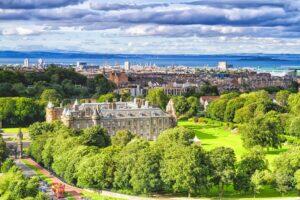Fodor's Expert Review High Street
The High Street (one of the five streets that make up the Royal Mile) is home to an array of impressive buildings and sights, including some hidden historic relics. Near Parliament Square, look on the west side for a heart mosaic set in cobbles. This marks the site of the vanished Old Tolbooth, the center of city life from the 15th century until the building's demolition in 1817. The ancient municipal building was used as a prison and a site of public execution, so you may witness a local spitting on the heart as one walks by—for good luck.
Just outside Parliament House lies the Mercat Cross (mercat means "market"), a great landmark of Old Town life. It was an old mercantile center, where royal proclamations were—and are still—read. Most of the present cross is comparatively modern, dating from the time of William Gladstone (1809–98), the great Victorian prime minister and rival of Benjamin Disraeli (1804–81). Across High Street from the High Kirk of St. Giles... READ MORE
The High Street (one of the five streets that make up the Royal Mile) is home to an array of impressive buildings and sights, including some hidden historic relics. Near Parliament Square, look on the west side for a heart mosaic set in cobbles. This marks the site of the vanished Old Tolbooth, the center of city life from the 15th century until the building's demolition in 1817. The ancient municipal building was used as a prison and a site of public execution, so you may witness a local spitting on the heart as one walks by—for good luck.
Just outside Parliament House lies the Mercat Cross (mercat means "market"), a great landmark of Old Town life. It was an old mercantile center, where royal proclamations were—and are still—read. Most of the present cross is comparatively modern, dating from the time of William Gladstone (1809–98), the great Victorian prime minister and rival of Benjamin Disraeli (1804–81). Across High Street from the High Kirk of St. Giles stands the City Chambers, now the seat of local government. Built by John Fergus, who adapted a design of John Adam in 1753, the chambers were originally known as the Royal Exchange and intended to be where merchants and lawyers could conduct business. Note how the building drops 11 stories to Cockburn Street on its north side.
A tron is a weigh beam used in public weigh houses, and the Tron Kirk was named after a salt tron that used to stand nearby. The kirk (church) itself was built after 1633, when St. Giles's became an Episcopal cathedral for a brief time. In 1693 a minister here delivered an often-quoted prayer: "Lord, hae mercy on a' [all] fools and idiots, and particularly on the Magistrates of Edinburgh."
READ LESS




